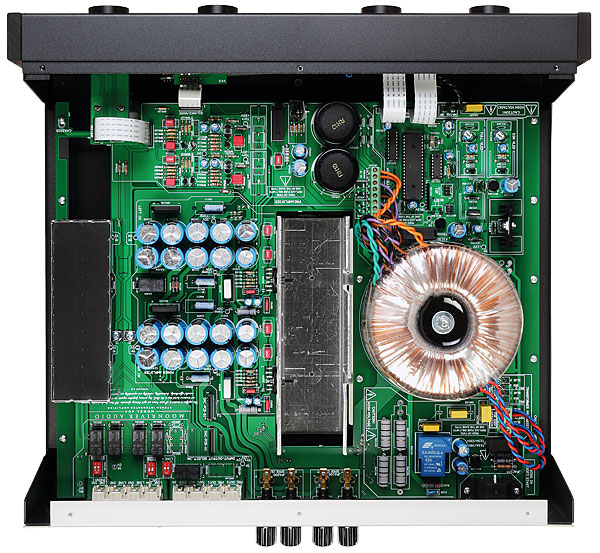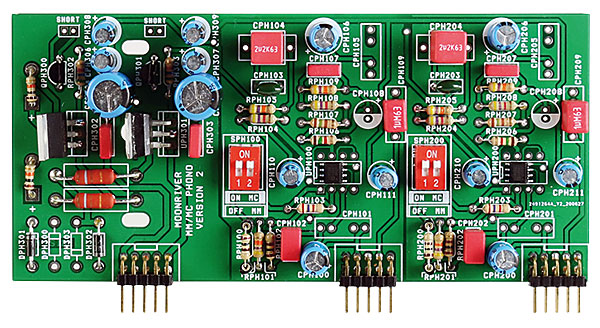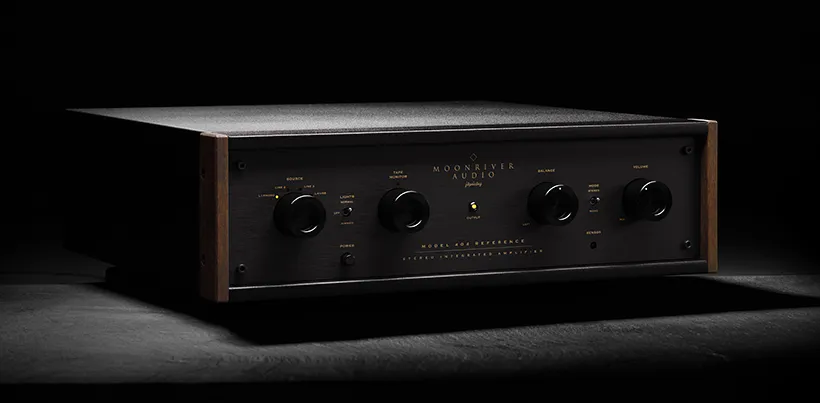We have our first Swedish product today! I didn’t know of any Swedish companies that manufactured Hi-Fi gear; Sweden is one of the most expensive countries in the world, and naturally, that drives manufacturing costs up. So you can imagine my curiosity when I found out about the Moonriver 404 Reference, an integrated amplifier hand-built in Sweden.
Moonriver Audio is a Swedish manufacturer known for blending classic design with modern engineering. Every product is assembled by hand in Sweden, using carefully selected components and a modular approach that allows for future upgrades. Their focus is on delivering music with natural tone, dynamic energy, and the kind of long-term reliability audiophiles value. The 404 Reference is an upgraded version of the original Moonriver 404, with the main change being a redesigned power supply.
Moonriver 404 Reference Price
The base Moonriver 404 Reference price starts at $6,000 / £4,499. Optional modules and upgrades include:
- Moving Magnet (MM) phono stage module: $645 / £475
- Moving Magnet (MM) + Moving Coil (MC) phono stage module: $745 / £549
- SPDIF DAC module: $745 / £549
- USB DAC module: $1015 / £749
Design And Build Quality
The Moonriver Audio 404 Reference is an integrated power amplifier. There are no design changes between the standard 404 and the 404 Reference; only the font color changes from white to gold. It has four black metal dials on the front panel, along with two toggle switches, a power button, and an output LED.

The dials have a satisfying click and a good amount of resistance when you rotate them. There is one dial each for source selection, volume, balance controls, and the tape monitoring loop. The left toggle switch is used for dimming the LEDs, and the right switch is used to toggle between stereo and mono mode.
On the back panel, the 404 Reference has four line-level RCA analog inputs, a pair of inputs and outputs for the tape loop, one preamp input and output, and two sets of high-quality WBT speaker terminals. The chassis reduces unwanted resonances by incorporating better materials and better integral mechanical support.

The Internals
Just like the standard model, the Moonriver 404 Reference makes use of five power supplies, each fed by a big toroidal transformer, and each featuring overload protection. It has a max output power of 50W into 8 ohms, which might seem a little low, but we’ll talk about this later. The power amplifier runs on a dual mono configuration, and the total capacitance is a whopping 107000µF, of which 21000µF are reserved for the preamplifier. This is an increase over the standard 404s 57,000 µF, and improves the dynamic and extracts more detail. The 404 Reference also has improved isolation and damping for the circuitry.
The internals include a motorized ALPS Blue volume control unit for volume attenuation, and a soft start circuit based on 30A relay input switches. The Moonriver 404 also makes use of some modules not seen at this price point, which are power amplifier chips. More specifically, the Texas Instruments LM3886 Class A/B chips. These types of chips are usually seen in amplifiers under $1000, and this seems like a compromise Moonriver made to drive the price down.

Features
Tape Monitor Loop
The Moonriver 404 Reference integrated amplifier is the first product I’ve ever seen with a tape loop. This is a feature usually found in old stereo receivers and processors. A tape monitor loop allows you to connect external audio processors, like equalizers or effects units, to your system and monitor their effect on the audio signal before it reaches the main speakers.
Instead of routing the audio directly from your music source, like a CD player or turntable, the tape loop allows you to send the audio signal to an external device like an equalizer, and then back into your amplifier for playback. You can hear the processed sound in real time and make adjustments as needed.
Balance Control
Balance control is a feature you see less and less in new products. I find this feature a must in every amp, that is because you cannot position your speakers in complete symmetry in your room. Most rooms were not designed for ideal listening, and it is very common when one speaker is placed closer to the room boundaries and the other one isn’t. This discrepancy messes with your frequencies, and though you might not notice, you aren’t able to get the best sound. Balance control helps even your volume levels and frequencies out, and this minor tweak results in better sound and a more focused soundstage.
Setting Up The Moonriver 404 Reference
I got the base module of the 404 Reference, but you can upgrade to get a Moving Magnet phono stage input, a Moving Magnet + Moving Coil phono stage input, and a USB or an SPDIF DAC. I used the Moonriver 404 Reference with my SourcePoint 888 loudspeakers, and since I didn’t get the DAC module, I also connected it with my HiFi Rose RD160 DAC.
What’s good is that the 404 Reference has a modular architecture, which means fitting these modules is simple and can take place at any time, on or after purchase. The USB DAC may also be upgraded to a newer version to meet future needs and technologies.

Sound Quality
Now, about that 50-watt power output I mentioned earlier. On paper, it seems modest compared to the 100+ watt amplifiers dominating the market, but those five power supplies and 107,000µF of capacitance work together to deliver current when it matters most, and the dual mono configuration ensures each channel gets dedicated power reserves. During my testing with the SourcePoint 888 loudspeakers, I never once felt the 404 Reference was struggling, even when pushing them to impressive levels.
The synergy between the 404 Reference and the SourcePoint 888s was immediately apparent. The 888s’ concentric driver design demands an amplifier that can maintain precise imaging, and the 404 Reference delivered exactly that. Vocals remained locked in the center of the soundstage with remarkable stability, while instruments spread naturally across the width of my room. Playing Diana Krall’s “The Look of Love,” her intimate vocal delivery maintained perfect clarity and emotional nuance without any strain, even during the most dynamic passages where lesser amplifiers might compress or lose composure.
The bass performance was particularly impressive given the power specifications. The dual 8-inch woofers in the SourcePoint 888s can be demanding, but the 404 Reference controlled them with authority that pretty much defied its 50W rating. Testing with The Weeknd’s “Dawn FM”, that deep electronic bass foundation hit with genuine impact while maintaining articulation. Zero bloat, zero overhang, just clean, controlled low-end extension that revealed the upgraded power supply’s influence.
Through my HiFi Rose RD160 DAC, the 404 Reference revealed its true character: neutral, honest, and surprisingly dynamic. The midrange presentation was particularly captivating; it was natural without coloration, detailed without harshness. Piano recordings through this chain sounded exceptionally convincing, with each note carrying proper weight and decay. The LM3886 chips, despite being more commonly found in budget amplifiers, proved well-implemented here. Whatever compromises Moonriver made to hit their price point, they didn’t sacrifice coherence or quality.
The high-frequency reproduction struck an ideal balance between detail and listenability. That smooth, extended treble never became fatiguing during longer listening sessions, something I particularly appreciated when listening through Daft Punk’s “Random Access Memories.” The album’s layered production and compressed dynamics remained engaging rather than aggressive through the 404 Reference. Acoustic guitars retained their natural shimmer, while the intricate electronic textures decayed with realistic detail, a testament to the amplifier’s refined character.
The 404 Reference created a wide, stable image that remained locked in place regardless of listening position. During complex orchestral pieces, individual sections maintained proper spacing and depth, creating that coveted “disappearing speaker” effect. The SourcePoint 888s’ already excellent imaging was enhanced further, with precise instrument placement and natural depth perspective.
After 2 weeks of listening, the Moonriver 404 Reference consistently delivered one key quality: musical engagement. Whether playing acoustic recordings or complex electronic productions, it maintained that essential connection between me and the music.
Verdict: Should You Get The Moonriver 404 Reference?
The Moonriver 404 Reference reminds us why we fell in love with high-end audio in the first place. It creates that connection between you and your music, which very few products achieve. At this price point, you could choose amplifiers with higher power ratings or more extensive feature sets. But few competitors match the 404 Reference’s combination of build quality, musical coherence, and upgrade flexibility.
Pros:
- Exceptional build quality and Swedish craftsmanship
- Modular design allows future upgrades
- Drives difficult speakers despite modest power rating
- Neutral, musical sound signature
- Excellent tape monitor and balance controls
- Long-term reliability focus
Cons:
- High price for 50W output
- LM3886 chips seem modest for this price point
- Requires quality speakers to shine
Specifications
Inputs: 5 (line 1 and 4 optionally occupied by phono stage and USB DAC, respectively, 1 x tape loop)
Outputs: 2 x preamp out, 1 x rec out
Max. output power: 50 W per channel into 8 Ω
Frequency response: 10 Hz to 50 kHz
Total harmonic distortion: 0.05%
Signal to noise ratio: 85 dB (line)
Idle Consumption: 22 Watts
MM phono stage gain: 40dB
MC phono stage gain: 60 dB
MM input impedance: 47KΩ
MC input impedance: 100 Ω
Input capacitance: 100pF
Dimensions (mm): 430 (W) x 390 (D) x 135 (H)
Weight: 13 kg
Not sure what these specs mean? Check out our Guide To Speaker Specifications.
Price
$6,000 / £4,499
